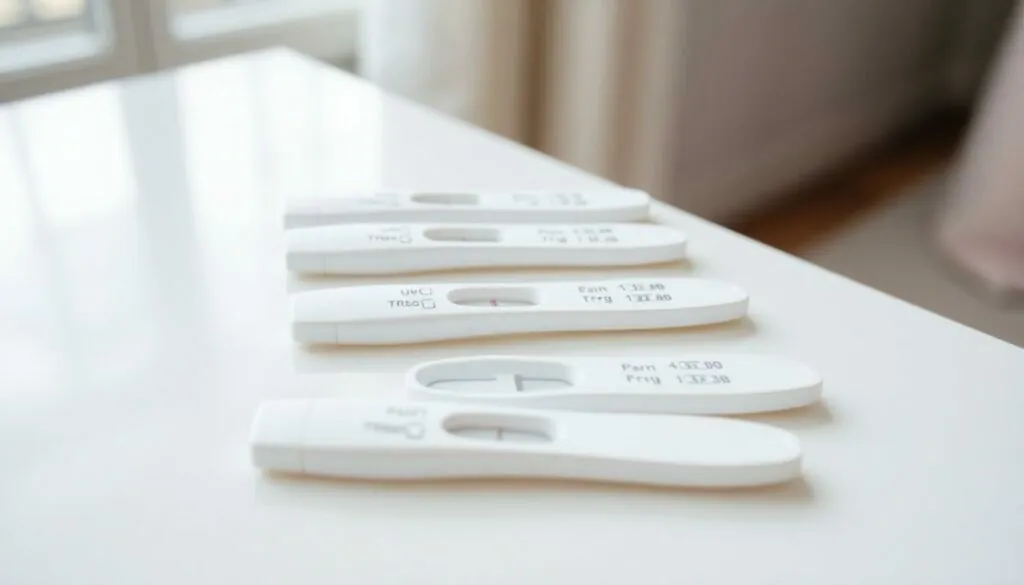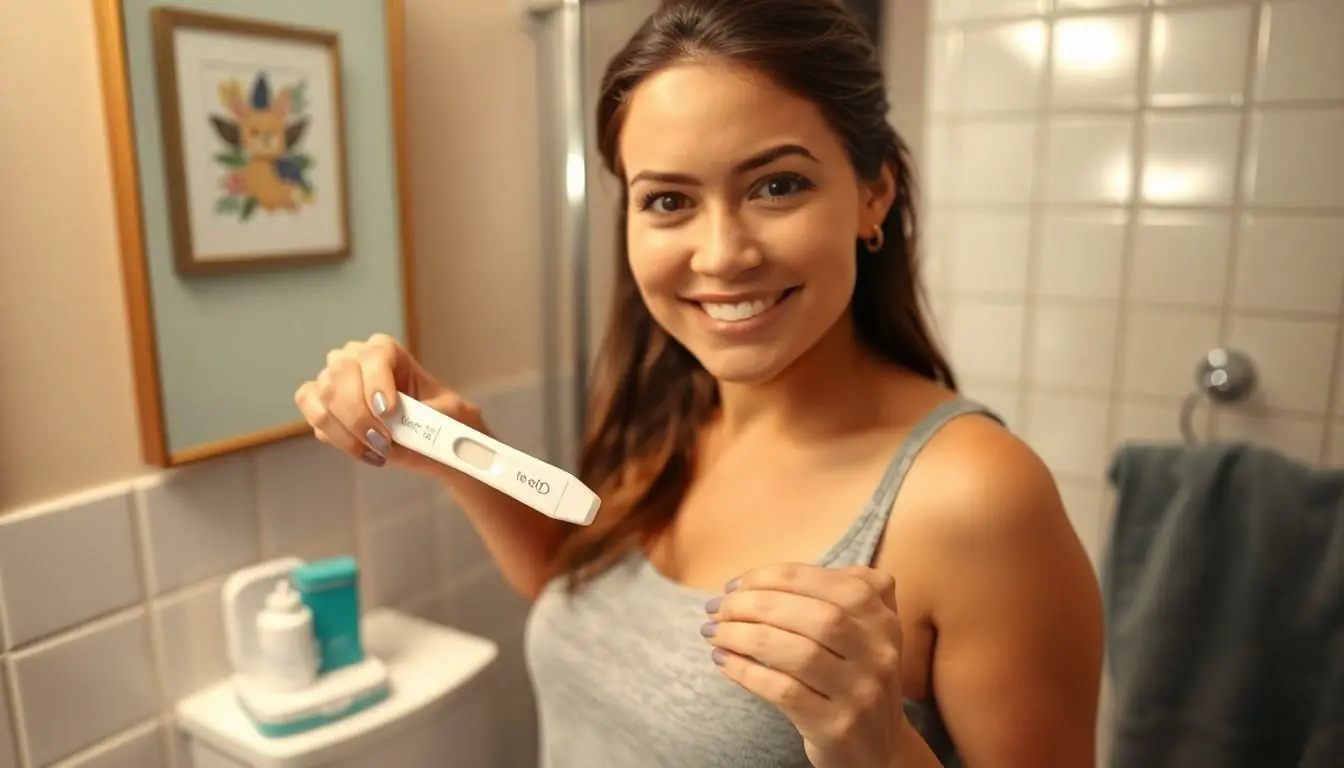Table of Contents
ToggleFinding out if there’s a baby on board shouldn’t cost as much as the baby’s first outfit. That’s where strip pregnancy tests come in – the no-frills, budget-friendly way to get answers about potential parenthood. These simple paper strips pack the same scientific punch as their fancy digital cousins but without the bells, whistles, and hefty price tag.
What makes these little strips so special? They’re the same tests many doctors’ offices use, detecting pregnancy hormones with impressive accuracy. While they might not have a digital screen showing a baby emoji or a fancy plastic case, they’ll tell you what you need to know – plus or minus, baby or no baby. For savvy shoppers and frequent testers, these affordable alternatives make perfect sense.
What Are Strip Pregnancy Tests?
Strip pregnancy tests are thin strips of paper infused with specialized chemicals that detect pregnancy hormones in urine. These basic testing tools offer accurate results without digital displays or plastic casings.
How Strip Tests Detect Pregnancy
Strip pregnancy tests identify human chorionic gonadotropin (hCG) hormones present in urine during pregnancy. The test contains antibodies that bind to hCG molecules, creating a visible line in the test window. The control line appears first to confirm the test works correctly, followed by a second line indicating pregnancy when hCG levels reach 25 mIU/mL or higher. The intensity of the second line varies based on hCG concentration levels in the urine sample.
Types of Strip Tests Available
Early detection strip tests identify pregnancy 5 days before a missed period. Standard sensitivity strips work best on the first day of a missed period. Ultra-sensitive strips detect minimal hCG levels at 10 mIU/mL. Midstream strips feature a wider handling area for direct urine testing. Combo packs include both strip tests plus specimen cups for multiple testing options. Each type comes individually wrapped in foil packets to maintain testing integrity through proper storage conditions.
Benefits of Using Strip Pregnancy Tests
Strip pregnancy tests offer essential advantages that make them a practical choice for early pregnancy detection. Their simple design combines accuracy with affordability, making them accessible to more users.
Cost-Effectiveness
Strip pregnancy tests cost 80% less than digital pregnancy tests while maintaining the same accuracy levels. A pack of 25 strips typically costs $10-15, compared to $15-20 for a single digital test. This price difference allows users to perform multiple tests throughout their pregnancy journey without significant financial impact. Bulk purchasing options provide additional savings, with some manufacturers offering 50-100 test strips at discounted rates. Medical facilities often use these same strips, confirming their reliability at a fraction of the retail cost.
Convenience and Privacy
Strip pregnancy tests fit discreetly in small purses, wallets or pockets, measuring just 3-4 inches in length. Users can perform tests at home without scheduling medical appointments or visiting pharmacies repeatedly. The compact packaging enables discrete disposal, with each strip wrapped individually in foil. Storage requires minimal space, as 25 strips occupy the same space as two digital tests. The simple instructions come in multiple languages, making them accessible to diverse users. Testing takes 5 minutes from start to finish, providing quick results in private settings.
How to Use Strip Pregnancy Tests
Strip pregnancy tests provide accurate results through a simple urine testing process. Following the correct testing procedure ensures reliable outcomes.
Step-by-Step Testing Instructions
- Remove the test strip from its sealed pouch immediately before use
- Collect urine in a clean cup
- Dip the marked end of the strip into urine for 5-10 seconds
- Place the strip flat on a non-absorbent surface
- Read results within 3-5 minutes
- Look for two distinct lines in the test window:
- Control line appears first
- Test line indicates pregnancy
- Discard the test after 10 minutes
Important Notes:
- Keep strips sealed until testing
- Use room temperature urine
- Avoid touching the test window
- Don’t read results after 10 minutes
Best Time to Test
Testing accuracy increases when performed at specific times:
Optimal Testing Times:
- First morning urine contains highest hCG levels
- Tests detect pregnancy 6-8 days after ovulation
- Morning testing provides most accurate results
- Wait until first day of missed period for 99% accuracy
| Days Past Ovulation | Accuracy Rate |
|---|---|
| 6-7 days | 50-75% |
| 8-9 days | 75-85% |
| 10+ days | 85-99% |
| Missed Period | 99% |
Accuracy and Reliability
Strip pregnancy tests demonstrate 99% accuracy when used correctly, matching the reliability of expensive digital tests. Laboratory studies confirm these tests detect pregnancy hormones with precision comparable to medical-grade equipment.
Sensitivity Levels
Strip pregnancy tests feature varying sensitivity thresholds for detecting hCG hormones:
- Ultra-sensitive strips detect hCG levels as low as 10 mIU/mL, enabling early pregnancy detection 4 days before a missed period
- Standard sensitivity strips identify hCG at 25 mIU/mL, ideal for testing from the first day of a missed period
- Low sensitivity strips measure hCG at 100 mIU/mL, useful for monitoring pregnancy progression
| Sensitivity Level | Detection Threshold | Best Testing Time |
|---|---|---|
| Ultra-sensitive | 10 mIU/mL | 4 days before period |
| Standard | 25 mIU/mL | First day of missed period |
| Low | 100 mIU/mL | 1-2 weeks after missed period |
Common Causes of False Results
Several factors impact strip pregnancy test accuracy:
- Expired test strips produce unreliable results due to degraded chemical reagents
- Diluted urine samples contain insufficient hormone concentrations for detection
- Medications containing hCG interfere with test reactions
- Reading results outside the 3-5 minute window leads to evaporation lines
- Contaminated test strips from improper storage show inaccurate results
These tests generate false positives from:
- Chemical pregnancy
- Fertility treatments containing hCG
- Recent miscarriage or pregnancy
- Certain medications or medical conditions
- Testing too early
- Using diluted urine samples
- Incorrect test procedure
- Defective test strips
Comparing Strip Tests to Digital Tests
Strip pregnancy tests offer significant differences in pricing, features and accuracy compared to digital pregnancy tests. These variations impact both accessibility and user experience.
Price Differences
Strip pregnancy tests cost $0.30-$0.60 per test when purchased in bulk packs of 20-25 strips. Digital pregnancy tests range from $8-$15 for a single test. A pack of 25 strip tests priced at $10-$15 provides the same core testing function as digital tests at 80% less cost per test. The price difference stems from digital tests including electronic displays, plastic casings and battery-powered features that don’t affect the fundamental testing mechanism.
| Test Type | Cost per Test | Pack Size | Pack Price |
|---|---|---|---|
| Strip | $0.30-$0.60 | 20-25 | $10-$15 |
| Digital | $8-$15 | 1-2 | $8-$30 |
Accuracy Rates
Both strip tests and digital tests detect pregnancy with 99% accuracy when used correctly on the first day of a missed period. Strip tests identify hCG levels as low as 25 mIU/mL, matching the sensitivity of standard digital tests. Ultra-sensitive strip tests detect hCG at 10 mIU/mL, enabling earlier testing than most digital options. Independent laboratory studies confirm equivalent accuracy between strip and digital formats despite their price difference.
| Test Type | Accuracy Rate | Minimum hCG Detection |
|---|---|---|
| Standard Strip | 99% | 25 mIU/mL |
| Ultra-Sensitive Strip | 99% | 10 mIU/mL |
| Digital | 99% | 25 mIU/mL |
Storage and Expiration Guidelines
Strip pregnancy tests maintain optimal accuracy when stored between 36-86°F (2-30°C) in a dry environment. Excessive heat temperature changes affect the test’s chemical composition rendering results unreliable.
Storage Requirements
- Keep tests sealed in original foil pouches until use
- Store in a cool dark drawer away from direct sunlight
- Avoid bathroom storage due to moisture exposure
- Maintain consistent room temperature conditions
- Place away from cleaning products chemicals
Checking Expiration Dates
Each test strip package displays an expiration date typically 12-24 months from manufacture. Tests remain accurate through this date when properly stored. A color indicator on many test pouches turns from pink to yellow if exposed to compromising conditions.
| Storage Condition | Impact on Test Reliability |
|---|---|
| Room Temperature (36-86°F) | Maintains accuracy |
| Direct Sunlight | Degrades chemicals |
| High Humidity (>80%) | Affects results |
| Freezing Temperature | Damages test strip |
| Chemical Exposure | Invalidates results |
Signs of Damaged Tests
- Discolored or faded test strips
- Damaged or open foil packaging
- Visible moisture inside sealed pouch
- Test window appears cloudy or spotted
- Control line fails to appear during testing
Using expired or improperly stored tests increases the risk of inaccurate results. Chemical reactivity diminishes over time affecting the test’s ability to detect pregnancy hormones correctly.
Conclusion
Strip pregnancy tests offer a reliable and cost-effective solution for anyone seeking to confirm pregnancy. Their 99% accuracy rate matches that of expensive digital alternatives while providing significant savings through bulk purchasing options. These simple yet effective tools have revolutionized home pregnancy testing by making it accessible and affordable for everyone.
The combination of accuracy convenience and affordability makes strip pregnancy tests an excellent choice for those who need frequent testing or prefer a more economical option. When stored properly and used according to instructions these tests deliver dependable results that empower users to make informed decisions about their reproductive health.





